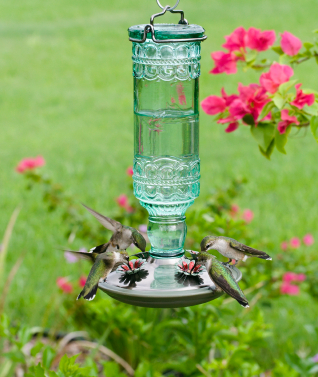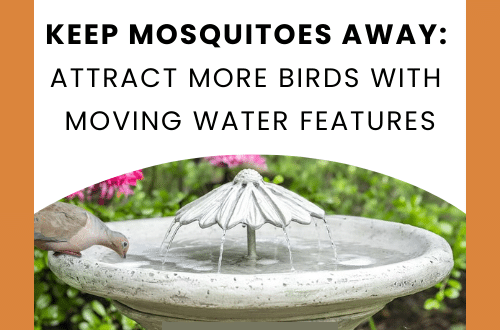-
Extra Hummingbird Feeders…please?
 It’s that time of year again, when the daylight hours start to dwindle, and the southern migrations begin. Most notably, the hummingbird migration, because if you’ve been feeding the little sprites through summer… there’s no way you can miss the frenzy around feeders!
It’s that time of year again, when the daylight hours start to dwindle, and the southern migrations begin. Most notably, the hummingbird migration, because if you’ve been feeding the little sprites through summer… there’s no way you can miss the frenzy around feeders!Activity around hummingbird feeders is just mad! Almost in a frantic, and desperate attempt to guard their spots, hummingbirds are buzzing like crazy, and drinking down nectar from big feeders in a matter of one to two days.
They know it’s critical to fatten up for the long journey back to Central and South America, just imagine how much fuel that takes? And summer weather has not been kind to them…or any other wildlife for that matter 🙁
The brutal temps and severe drought killed off most of the flowers and shrubs that provide nectar. This makes the trip for hummingbirds up North a bit more difficult. They’ll search for activity (other hummingbirds at feeders) as they make their way through the southern states.
Consider adding another feeder, or even two, that will increase the likelihood of more successful flights home. And if you think your hummingbirds are gone, please wait for the slow-pokes and stragglers! Some folks keep feeders out year-round, as strange sitings have revealed the migratory bird in northern states during frigid winter months.
Nectar solutions may also be increased this time of year to benefit hummingbirds. The usual ratio of 4:1 is perfect during lazy summer months, but these guys mean business now! Increase the ratio to a 3:1 solution for added calories. Three cups of water to one cup plain table sugar. If you feed commercial nectar mixes, just use about 25% less water for an added punch.
If hummingbirds graced your yard this year, chances are they’ll be back next year. Practicing “site fidelity” is another really cool thing about these fascinating birds. And hey, even if it’s just one of those little plastic inexpensive hummingbird feeders (that doesn’t much appeal to you) they will absolutely appreciate and love it right now!
-
cool bird baths meld with nature
 Elements found in the natural world are sometimes those that create a most unique setting or focal point in the landscape. Trends even point toward man-made items using recycled materials which create a finished piece that imitates nature herself. Most common in textile design, it’s spreading to all sorts of products these days.
Elements found in the natural world are sometimes those that create a most unique setting or focal point in the landscape. Trends even point toward man-made items using recycled materials which create a finished piece that imitates nature herself. Most common in textile design, it’s spreading to all sorts of products these days.Of these two unique bird baths, one is wood, and one is handcrafted using 60% recycled materials. Can you tell which is which? Actually, it’s pretty amazing stuff!
The first bath is teak, and you may think: Teak? Yes, because of the durable properties, and denseness of the wood, it makes for a really cool bird bath (no pun intended). Birds bathe naturally at ground level, and this beauty, complete with non-toxic sealant, provides an excellent water source to entice feathered friends. It’s simply gorgeous in the landscape, and durable just like that high-end teak furniture we all dream of having!
Now this is the bird bath that’s hand made using mostly recycled materials, but you’d absolutely swear it was cut from a huge old tree! The shape, texture, and color all say this is a piece of tree… but it’s not!
Any ground bath may be placed on a deck for great close up views of your birds. An old tree stump is ideal for placing one too. A plant stand, or even an interesting planter all make perfect choices for supporting a ground bath.
By the way, fresh water really is the best way to attract more birds, especially with the terrible heat and drought that’s plagued most of the country this summer. Just keep water fresh… and the birds will come!
-
unique bat houses attractive to humans too!
Increasing in popularity as a better option for natural insect control, bat houses have come a long way in the past few years. Because installation may be on a structure; your house or an out building on the property, as well as a tree or pole, they may remain in full view. Thus some newer styles are more detailed with an aesthetic that encourages folks to utilize them. By quitting the pesticides, your yard will see more birds, butterflies, and more flowers, and a healthier environment all the way around!
This Victorian style bat house is handcrafted in the USA of solid cypress. The shingled roof and slat-front detail are really just for us humans, while the double chamber living quarters with landing pad is attractive to bats. Expect a double-chamber model to house about 100 bats. Cypress offers a stable environment for bats by keeping ambient temperatures level or constant.
A single chamber bat house offers roosting for about twenty or so bats. This is a good way to get started to lure the beneficial furry friends to your place. This vintage style home offers a very cool design element not found with the “standard box” models. Again, handcrafted in solid cypress, it proves to be durable for many years of use.
Either of these fine bat houses would make a unique addition to the landscape. If you happen to be near a pond or creek, chances are favorable at luring occupants. For more information on bats and their benefits, visit OBC, the Organization for Bat Conservation.




